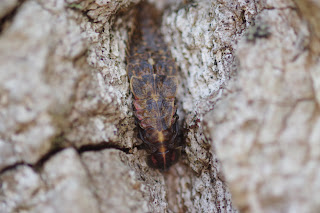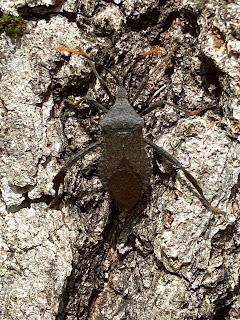I used to be able to do yard work without being distracted by bugs (other than any that tried to bite me), but that is no longer the case. Today, for instance, we were doing some raking, and when I leaned my rake against a tree to pick up clippers to cut some bittersweet vines, I naturally checked the tree trunk for interesting insects. And I found some. Which then distracted me for the rest of our work time, but really, it was hard not to be fascinated. But I have to show you what I found for you to understand...
Backyard Bug of the Day:
Firefly (aka lightning bug) pupa! It took me about a minute to understand what this was–I thought it was a new species of insect for me, and an adult, but then I saw this...... and it occurred to me what I was actually seeing. I think this imago (adult) firefly had eclosed from that pupal case, and was still hanging out, getting ready to take on the world. I was out there for a few hours, and this firefly was there for most of the time, until...
It decided it was ready to explore.Note the light-up bits of its abdomen, visible under its elytra.
There were a LOT of these pupae on the tree, but also some exuviae (the leftover pupal case that the fireflies have emerged from:
For most of them it appeared that the fireflies have not emerged yet:
Some of them did appear to be empty:
This one shows pretty clearly the line where the pupal case will split open when the firefly emerges.
I am not sure it this one had only recently eclosed and its wings and elytra were not straight yet, or if it was deformed:
I went out after dark to see if there would be fireflies lighting up the night, and there were. One of the best things about summer–although it's not summer yet.
I took a lot of the firefly pictures with my phone, but when we were done working I went inside and got my camera. It's a shame I didn't have it outside with me the whole time, because we uncovered (and annoyed) a lot of insects and spiders while we were raking–it wasn't a grassy area we were raking, but dirt, and there was a LOT going on under that leaf litter. But they had scattered by the time I got my camera.
Okay, we're going to just ignore the fact that I have been a slacker about blogging (and that is putting it mildly) for the last several years, and proceed with all of the other bugs that would have been Backyard Bugs of the Day (and other bugs) for the rest of this week. I didn't do a camera walk all week because I didn't have time–camera walks take at least two hours, and I didn't have that much time for walking this week (and, actually, there were a few days I couldn't go out into the woods because of the high winds).
Other Bugs:
Firefly. I am not sure if this is a winter firefly, or another species that is just coming active for the season.
A couple of pictures of bugs in a stream (sorry, they're terrible, because I took them really zoomed in with my phone. And they're underwater):
Caddisfly larvaI don't know what kind of larva this is.Okay, this isn't an insect, it's a tadpole.
And this is a salamander egg mass. It looks like some of them have hatched, but there are still a few larvae in there. Unfortunately, the pond has completely dried up now. We didn't get the forecasted rain on Saturday, and now the forecast for Sunday's rain has been rescinded, so I don't have much hope for the salamanders. Alas.Leaf-footed bug
Caterpillar from last night's night hike
Caddisfly. Also from last night's night hike.
Twice-stabbed lady beetles
Six-spotted tiger beetle. I saw my first one for the year last week, and was excited because I love these beetles. This was the first one I was able to photograph, though–they are camera-shy.
This one I saw today didn't let me get nearly as close.Twice this week I saw this species of beetle on my path. This one seemed to be trying to dig into the ground (which made it easier to photograph than the other one, which kept running under leaves and hiding).
Tent caterpillars have emerged.



































































